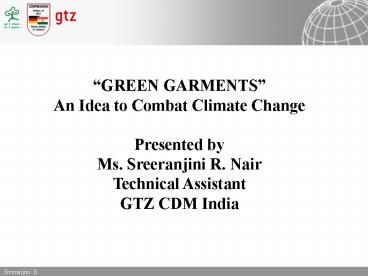PowerPointPrsentation - PowerPoint PPT Presentation
1 / 13
Title:
PowerPointPrsentation
Description:
... will provide the apparel industry with a blueprint in ethical and sustainable production. ... for the Indian apparel/ textile industry to choose the path ... – PowerPoint PPT presentation
Number of Views:75
Avg rating:3.0/5.0
Title: PowerPointPrsentation
1
GREEN GARMENTS An Idea to Combat Climate
Change Presented by Ms. Sreeranjini R.
Nair Technical Assistant GTZ CDM India
2
- The only course of action to change
business-as-usual practices and genuinely reduce
any emissions that contribute to global warming
is the reduction of on-site energy consumption,
and a switch from fossil fuel to renewable energy.
3
Clothing is responsible for approximately one ton
of each individuals CO2 emissions (including
washing and drying)
- Green Garments/apparelwhat does it mean?
- Garments that are
- Organic and ethically made.
- Manufactured solely using sustainable renewable
energy. - It can be considered as the immediate and
practical solution for the apparel/textile
industry to combat their biggest challenge- the
Climate Change
4
How the idea of green garments be made
possible? Low impact farming Environment
friendly production methods Renewable energy
Low water footprint Transportation
Biodegradable packing Wash cool / Line dry
5
Low impact farming organic farming that is no
use of petroleum based chemical fertilizer,
pesticide or herbicide hence less reliant on
fossil fuels Using regions where organic cotton
is planted and harvested by hand - without
mechanization Low Water Footprint It can take
more than 20,000 litres of water to produce 1kg
of cotton, equivalent to a single T-shirt and
pair of jeans so the best choice would be to use
region that receives up to 95 of its water from
the monsoon rain. This will also reduce the need
for large-scale irrigation projects, which often
deprive local villages of scarce water resources
by draining lakes and rivers.
6
Waste water treatment The processing of the dye
effluent should take place in a controlled
closed- loop purification system that uses
treatment ponds, sand filtration and reverse
osmosis to convert the wastewater into clean
water. Transportation No Airfreight policy
-transport goods by containerised ocean
shipping, and therefore the carbon footprint
generated by transporting the apparel to foreign
nations is negligible, more like a carbon
fingerprint.
7
- Bio degradable Packaging
- PVC-free packaging
- Using 100 recycled cardboard boxes
- Wash- cool Line-dry instruction
- Consumer instructions to Minimise /no use of
machines for washing and tumble drying. - Recommend eco-friendly detergents, which have
minimal aquatic toxicity and will biodegrade
quickly and completely.
8
TrendsetterEarthPositive Apparel The most
progressive ethical clothing on Earth
- Carbon Trusts (an UK Govt. Establishment) first
carbon reduction label for textile products - Earth Positive is a unique product, a unique
concept and has sell-through into every
conceivable industry sector. Earth Positive is a
new business opportunity with none of the
negative effects of conventional business. - A green revolution in the promotional Carbon
neutral apparel - The purpose of EarthPositive apparel is to pass
forward competitive advantage to companies
looking for ways to act on climate change using
real products.
9
..continuation
- The development project for EarthPositive
apparel, that has taken two years to complete,
will provide the apparel industry with a
blueprint in ethical and sustainable production. - The Carbon Trust has asked for EarthPositive to
be used as a Case Study, so that the clothing
industry will benefit from their research and
development. - EarthPositive apparel has reduced the carbon
footprint of a T-shirt by up to 90. - made in carbon neutral manufacturing facilities
in India, from low impact organic cotton,
cultivated from areas which support Low water
footprint and is distributed through carbon
neutral warehouses and offices in London that use
only renewable green electricity.
10
..continuation
- The primary energy source for EarthPositive
apparel is thirty massive wind turbines that
generate a continuous source of renewable
electricity and also follows No Airfreight
policy. - Earth Positive apparel is a 100 organic product,
produced under the Global Organic Textile
Standard and certified by The Control Union and
The Soil Association. - Ethically made-The manufacturing facilities have
been audited by the Fair Wear Foundation, and are
being licensed by the FLO Fairtrade Labelling
Organisation.
11
- Changing consumer attitudes to climate change,
present forward-thinking companies with an
opportunity to develop and market low-carbon
products. - Any Company that makes an early public
commitment to carbon reduction in the public eye
may be perceived as the industry leader on
climate change.
12
- The pursuit of carbon reduction may act to
promote or safeguard the reputation and brand
value of a firm thereby supporting both the book
and market value of the company Hence time is
ripe for the Indian apparel/ textile industry to
choose the path of being Carbon Neutral
13
- THANK YOU FOR YOUR ATTENTION































